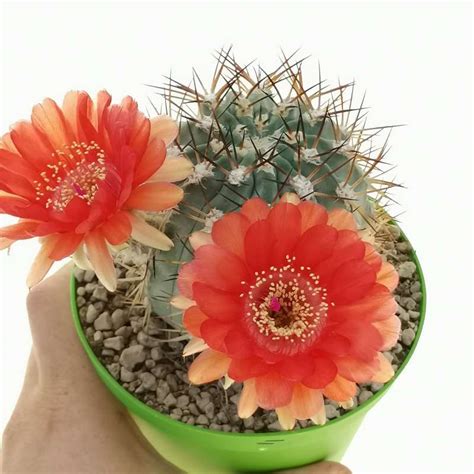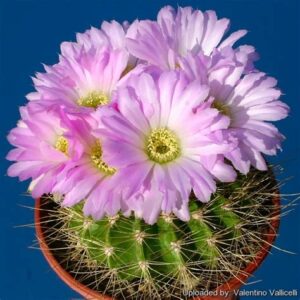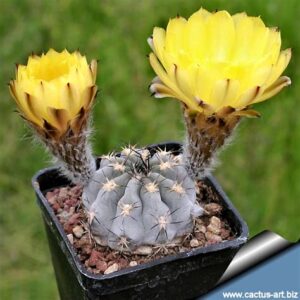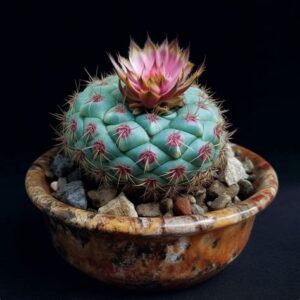The Acanthocalycium glaucum var. rubriflorum is a striking species within the Cactaceae family that offers both aesthetic delight and fascinating botanical intricacies. Renowned for its robust structure and distinct floral characteristics, this variegated cactus has captured the hearts of horticulturists and enthusiasts alike. As we delve into the world of this remarkable plant, prepare to embark on a journey that illuminates its origin, cultivation requirements, and the subtleties that make it a prized specimen in succulent collections.
Understanding the classification of Acanthocalycium glaucum var. rubriflorum provides valuable context. The genus Acanthocalycium is known for its perennial cacti, predominantly found in South America, particularly Argentina. This species name, “glaucum,” refers to the bluish-green coloration of the plant, while “rubriflorum” indicates the vibrant red flowers that emerge, contrasting beautifully against the plant’s flesh. Equipped with a unique combination of attributes, this variety achieves aesthetic excellence, enriching the biodiversity of personal gardens and public displays.
However, beyond its notable appearance lies its ecological significance and the role it plays in its natural habitat. The Acanthocalycium glaucum var. rubriflorum thrives in arid and semi-arid regions, demonstrating remarkable adaptations that allow it to survive with minimal water. Through various physiological processes, this cactus conserves moisture, making it a symbol of resilience in the face of environmental challenges. A closer examination reveals that the fascinating interplay between its structure and its ecology is responsible for its longevity and impressive growth.
In order to cultivate this enchanting cactus, potential growers must grasp the cultivation essentials that ensure its health and vitality. Its growing preferences require particular attention to soil composition, lighting conditions, and watering schedules. Understanding these fundamental requirements sets the stage for successful growth.
Soil selection is paramount for the Acanthocalycium glaucum var. rubriflorum. Ideal soil consists of a well-draining cactus mix, preferably incorporating coarse sand or perlite to promote optimal drainage. This prevents waterlogging, which can lead to root rot. Creating an appropriate potting mix provides the foundational support the plant needs for thriving growth. Combining equal proportions of potting soil with pumice or grit cultivates an ideal environment that emulates the plant’s natural habitat.
Light exposure also plays a crucial role in the development of the Acanthocalycium glaucum var. rubriflorum. While it requires plenty of bright sunlight to maintain its vibrant color and robust growth, growers must exercise caution regarding direct exposure to intense midday rays. A balance of direct morning sun and filtered light later in the day preserves the plant’s integrity, as too much sun can cause scorching, detracting from its visual appeal. Striking this balance demonstrates an appreciation for the plant’s complexities and needs.
Watering is another pivotal aspect to cultivate this remarkable cactus successfully. Like many succulents, the Acanthocalycium glaucum var. rubriflorum is drought-tolerant; hence it’s fundamental to avoid overwatering. During the growing season, typically from spring to early autumn, moderate watering every couple of weeks is sufficient. The soil should dry out between watering cycles, mimicking the natural rhythms of its native environment. However, during the dormant winter months, reducing watering to a minimal amount allows the plant to conserve energy. This nuanced approach to watering can result in a thriving specimen that delights the eye.
Promoting healthy growth extends beyond basic care; understanding the ecological nuances of Acanthocalycium glaucum var. rubriflorum encourages thoughtful cultivation and stewardship. This cactus not only serves an ornamental purpose but also supports local ecosystems. In its natural habitat, it attracts various pollinators, such as bees and butterflies, vital for sustaining biodiversity. By keeping this species within collections, we preserve its lineage and promote ecological education about the importance of native plants to their environments.
In addition to their ecological importance, the floral display of Acanthocalycium glaucum var. rubriflorum adds further intrigue. The blooming season often sweeps in late spring to early summer, yielding magnificent red flowers that capture the attention of passersby. These blooms blossom atop tall, vibrant stems and can reach several inches in diameter. Beyond their captivating appearance, these flowers are a crucial reproductive component, attracting pollinators and ensuring future generations of this diverse family. Any collector will attest to the joy of witnessing the transition from a seemingly simple cactus to an iridescent display of blooms.
However, as captivating as this variety may be, it is important to remain vigilant against common pests and diseases that can threaten its health. Among these culprits are mealybugs, spider mites, and scale insects. Regular inspections can go a long way in preventing infestations. Should a colony of these pests be discovered, horticulturists are advised to act promptly, employing treatment methods such as insecticidal soap or neem oil to address the issue effectively. An understanding of proper pest management ensures the longevity and vitality of Acanthocalycium glaucum var. rubriflorum.
Outside the realm of practical care, the Acanthocalycium glaucum var. rubriflorum serves as an emblematic representation of both beauty and tenacity. Incorporating this cactus into various environments stimulates contemplation regarding nature’s adaptability and resilience. Socially, it symbolizes the passion for preservation and highlights the significance of safeguarding native flora in cultivation practices. Consequently, as individuals find spaces in gardens or homes suited for its cultivation, they become part of a larger narrative surrounding plant conservation and horticultural artistry.
From the exploration of its characteristics to the practicalities of care, the Acanthocalycium glaucum var. rubriflorum presents a tapestry woven with appreciation for nature’s complexity. This extraordinary cactus showcases not only form but also function, offering a multifaceted view into the world of cacti. As it flourishes, it beckons curious minds to delve deeper into the arts of cultivation, the significance of ecological stewardship, and the enduring beauty that nature bestows. As a focal point of gardens and collections, the Acanthocalycium glaucum var. rubriflorum engages with the kaleidoscope of life, challenging us to embrace its unique attributes and celebrate the diverse tapestry that is our planet’s flora.
In conclusion, this remarkable cactus stands as both an object of beauty and an emblem of resilience, imbuing its caretakers with a deeper appreciation for the natural world. Engaging with the Acanthocalycium glaucum var. rubriflorum does not merely involve nurturing a plant; it encompasses a commitment to understanding the delicate balance between cultivation and conservation—an initiative that beckons exploration, respect, and admiration.





Leave a Comment